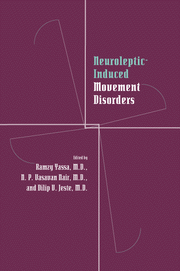Book contents
- Frontmatter
- Contents
- Contributors
- Preface
- Part I Historical perspective
- Part II Clinical aspects of tardive dyskinesia
- 2 Aging and tardive dyskinesia
- 3 Gender as a factor in the development of tardive dyskinesia
- 4 The Yale tardive dyskinesia study: a prospective incidence study among long-term outpatients
- 5 Vulnerability to tardive dyskinesia in schizophrenia: an exploration of individual patient factors
- 6 Tardive dyskinesia and affective disorder
- 7 Diabetes mellitus and tardive dyskinesia
- 8 Other factors in the development of tardive dyskinesia
- 9 Neuroleptic treatment and tardive dyskinesia
- 10 Anticholinergic drugs as factors in the development of tardive dyskinesia
- Part III Mechanisms underlying tardive dyskinesia
- Part IV Measurement of tardive dyskinesia
- Part V Tardive dyskinesia in different populations
- Part VI Other neuroleptic-induced movement disorders
- Part VII Treatment of tardive dyskinesia
- Index
9 - Neuroleptic treatment and tardive dyskinesia
from Part II - Clinical aspects of tardive dyskinesia
Published online by Cambridge University Press: 09 October 2009
- Frontmatter
- Contents
- Contributors
- Preface
- Part I Historical perspective
- Part II Clinical aspects of tardive dyskinesia
- 2 Aging and tardive dyskinesia
- 3 Gender as a factor in the development of tardive dyskinesia
- 4 The Yale tardive dyskinesia study: a prospective incidence study among long-term outpatients
- 5 Vulnerability to tardive dyskinesia in schizophrenia: an exploration of individual patient factors
- 6 Tardive dyskinesia and affective disorder
- 7 Diabetes mellitus and tardive dyskinesia
- 8 Other factors in the development of tardive dyskinesia
- 9 Neuroleptic treatment and tardive dyskinesia
- 10 Anticholinergic drugs as factors in the development of tardive dyskinesia
- Part III Mechanisms underlying tardive dyskinesia
- Part IV Measurement of tardive dyskinesia
- Part V Tardive dyskinesia in different populations
- Part VI Other neuroleptic-induced movement disorders
- Part VII Treatment of tardive dyskinesia
- Index
Summary
Any reasonable, informed clinician will accept the overwhelming epidemiologic evidence implicating neuroleptic drugs in the causation of tardive dyskinesia, with the caveat that not every case that looks like tardive dyskinesia is neuroleptic-related. Spontaneous dyskinesia (Marsden, 1985; Casey, 1987) and dyskinesias induced by drugs other than neuroleptics, such as antihistamines, antidepressants, and metoclopramide, often are indistinguishable from tardive dyskinesia. As Marsden (1985) pointed out, the causative relationship implies either that neuroleptics induce tardive dyskinesia in individuals who otherwise would not develop it or that neuroleptics precipitate tardive dyskinesia in patients who already carry the substrate for development of tardive dyskinesia.
Patients exposed to neuroleptics differ regarding variables such as age at first neuroleptic exposure, time since the start of neuroleptic treatment, duration of neuroleptic treatment (i.e., actual time on neuroleptics), number and duration of neuroleptic-free intervals, number of neuroleptics used, amount of neuroleptic (i.e., total quantity delivered), average neuroleptic dosage, and maximum neuroleptic dosage. Other areas of interest include comparisons of exposures to high- and low-potency neuroleptics, the number of neuroleptics simultaneously prescribed, the route of administration (depot vs. oral), and different schedules, such as a dose once daily versus twice daily (BID), or doses as needed (PRN) (oral and/or intramuscular). Only adequate knowledge of the pathogenesis of tardive dyskinesia will enable us to decide which of these drug variables are of particular relevance to tardive dyskinesia.
- Type
- Chapter
- Information
- Neuroleptic-induced Movement DisordersA Comprehensive Survey, pp. 104 - 116Publisher: Cambridge University PressPrint publication year: 1996
- 1
- Cited by

